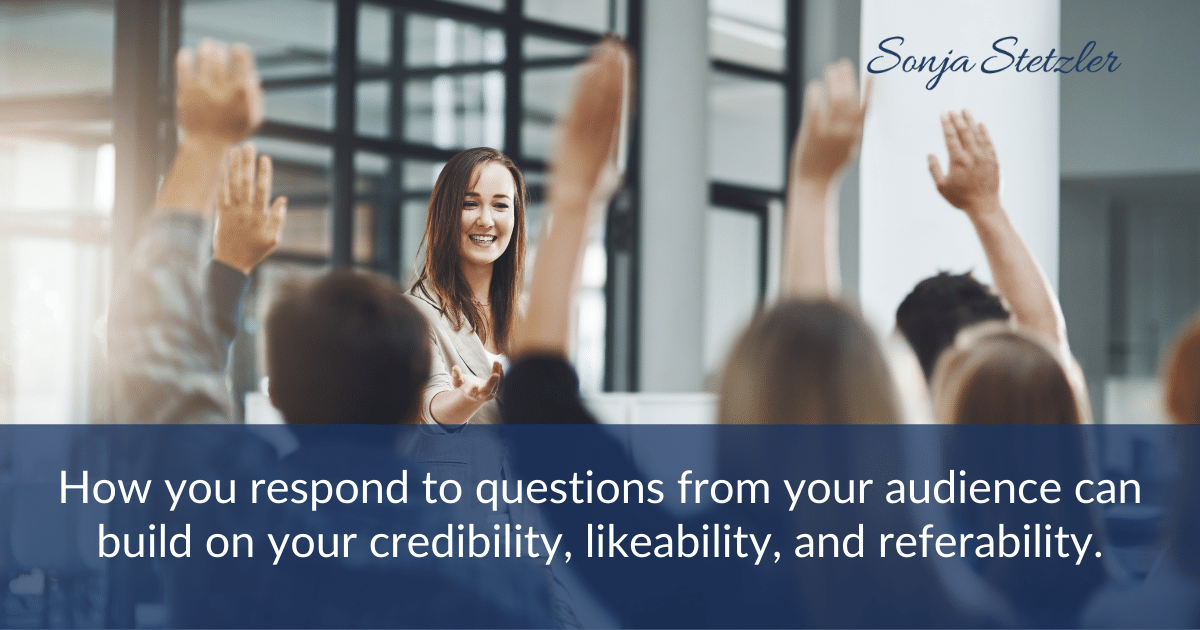In-person speaking is beginning to come back, so be prepared with these successful Q & A strategies.
One of the make-or-break components of a presentation that many clients don’t think much about is the Q & A. For many informational speakers, it is a time in their presentation for audience interaction, to clarify the content that was presented, and to go into further depth for better audience understanding.
How you respond to your audience with answers to their questions can build on your credibility, likeability, and referability. Or, just the opposite can occur if the Q & A is not handled well.
For some speakers, Q & A is a dreadful experience, where speaking off the cuff is uncomfortable and they feel they might get caught off-guard not knowing an answer to a question.
Here are strategies that can lead to a higher level of confidence during the Q & A which can leave your audience feeling satisfied, and build on the rapport and credibility you have built during your presentation.
Top 10 Q&A Strategies
1. Let your audience know upfront when you will be taking questions.
This sets expectations upfront, and audiences appreciate it when the rules of engagement are clear from the start.
2. Design your presentation so that Q & A is not left until the very end of your presentation.
It is commonly accepted that Q & A is at the end of the presentation. A more strategic place for Q & A is about ¾ of the way into your presentation. The reason for not placing Q & A at the end of your presentation is you want to leave your audience on a high note, and the last words in your presentation should be yours.
3. Pause for questions.
In the case of virtual presentations or a training presentation, pausing for questions after each topic allows for more engagement with your audience. Higher engagement, particularly with a virtual audience, translates into fewer participants clicking away.
4. Respond to questions with something other than, “That’s a good question!”
If some questions are good, how does this make an audience member feel if you don’t respond that they asked a good question? Alternatives to the above statement include:
“Thanks for your question. You’ve raised an important point.”
“This is a question that comes up quite often.”
“I’m glad you’ve asked that question.”
5. Ask a question of your own.
What if no one asks a question and there is dead silence? Give the audience a moment to process, then proceed to get the ball rolling with a question of your own that you frequently get asked. Say, “I’m often asked about x …”. Most audiences will pick up the ball from there.
6. Be sensitive to staying within your time limitations.
Let the audience know if the time for questions is running out. A statement such as, “We only have time for 2 more questions” signals that it is time to wrap things up. And you could offer to meet with audience members after the event.
7. Repeat the question.
For large audiences or for audience members who may have spoken in a soft voice, repeat the question back to the audience member who asked. This helps to clarify what was asked, it ensures that others in the audience heard the question, and it buys you a few extra seconds to craft your answer.
8. Asking “What questions do you have?”
This is more open-ended and sets the tone that you are expecting questions more so than, “Do you have any questions?”
9. Be aware of your non-verbal communication when you are answering a question.
Some speakers take a step back or cross their arms. This can send a signal that you are not confident or not prepared. Instead, take a step forward, make eye contact, and smile.
10. It’s OK not to know the answer.
Lastly, if you don‘t know the answer to a question, it is fine to say that you don’t know and that you will get back to the audience member who asked. People can tell if you are bluffing your way through an answer, and it will damage your credibility.
The Q & A portion of a presentation can be the highlight of the audience’s experience of you – especially if you are prepared, know your content well, and shift your mindset to one of enjoying the experience rather than dreading it. I hope that you will find these Q & A strategies helpful during your next presentation.

